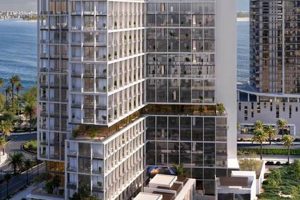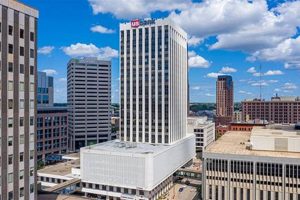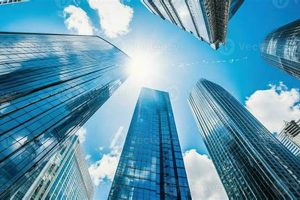A skyscraper, by definition, is a continuously habitable high-rise building having multiple floors, typically above 50 stories, that is designed for residential, office, or mixed-use purposes. Skyscrapers have become prominent features of skylines in major cities around the world, serving as landmarks and symbols of economic and architectural prowess. Their towering heights have transformed urban landscapes, shaping cityscapes and providing panoramic views for occupants and visitors alike.
The construction of skyscrapers has been driven by various factors, including land scarcity in urban areas, advancements in building technologies, and the desire for vertical expansion. They offer numerous advantages, such as increased population density and efficient land utilization, convenient access to amenities and transportation hubs, and enhanced energy efficiency due to reduced surface area exposure. Moreover, skyscrapers have become hubs for innovation and architectural experimentation, showcasing cutting-edge designs and sustainable building practices.
Throughout history, skyscrapers have played a significant role in shaping architectural styles and engineering feats. From the early skyscrapers of the late 19th century to the supertall structures of today, these buildings have pushed the boundaries of architectural design and construction techniques. They have served as canvases for architectural expression, influencing the aesthetics of cities and inspiring new design possibilities.
1. Height
Height is a defining characteristic of skyscrapers, differentiating them from other buildings and shaping their overall design and functionality. It is a crucial factor that influences numerous aspects of a skyscraper, from structural stability to occupant experience and urban planning.
- Structural Considerations: Height poses significant structural challenges, requiring innovative engineering solutions to ensure the stability and integrity of the building. Skyscrapers employ advanced structural systems, such as reinforced concrete cores, steel frames, and outrigger systems, to withstand lateral forces and maintain structural stability at great heights.
- Wind Resistance: Tall buildings are more susceptible to wind forces, which can cause swaying and discomfort for occupants. Skyscrapers are designed with aerodynamic shapes and incorporate features like tuned mass dampers to mitigate wind-induced vibrations and enhance structural resilience.
- Vertical Transportation: Elevators and other vertical transportation systems play a critical role in skyscrapers, facilitating efficient movement of occupants between floors. Advanced elevator technologies, such as double-decker elevators and high-speed lifts, are employed to reduce wait times and ensure smooth vertical circulation.
- Views and Daylight: The height of skyscrapers offers unparalleled views of the surrounding cityscape and natural landscapes. Floor-to-ceiling windows and open floor plans maximize natural light penetration, creating bright and inviting indoor environments for occupants.
In summary, the height of a skyscraper is not merely a measure of its physical stature but a complex interplay of structural considerations, wind resistance, vertical transportation, and occupant experience. It is a defining characteristic that shapes the design, construction, and functionality of these iconic structures.
2. Floors
The number of floors in a skyscraper is a fundamental aspect that influences its overall design, functionality, and impact on the urban environment. It is not merely a measure of its height but a complex interplay of various factors that shape the building’s character and purpose.
- Vertical Space Utilization: Skyscrapers maximize vertical space utilization by stacking multiple floors, creating ample space for various uses within a limited footprint. This efficient use of land resources is crucial in dense urban areas where land is scarce and expensive.
- Functional Diversity: The numerous floors in a skyscraper allow for a wide range of functions and uses, from residential apartments and office spaces to retail stores, restaurants, and recreational facilities. This diversity creates a vibrant and self-contained vertical community that caters to the needs of its occupants and visitors.
- Structural Considerations: The number of floors in a skyscraper directly impacts its structural design and engineering. Taller buildings with more floors require robust structural systems, such as reinforced concrete cores and steel frames, to ensure stability and withstand lateral forces like wind and seismic activity.
- Vertical Transportation: Efficient vertical transportation systems are essential in skyscrapers to facilitate movement between floors. Elevators, escalators, and other technologies are carefully planned to minimize wait times and ensure smooth traffic flow, especially during peak hours.
In conclusion, the number of floors in a skyscraper is not just a quantitative measure but a reflection of its functional diversity, structural complexity, and impact on the urban environment. It is a defining characteristic that shapes the design, construction, and utilization of these iconic structures.
3. Purpose
Purpose is a defining characteristic of a skyscraper, shaping its design, functionality, and impact on the urban environment. Skyscrapers are not merely tall structures; they are designed to serve specific functions that cater to the needs of their occupants and the surrounding community.
- Residential: Residential skyscrapers provide housing for a large number of people in a relatively small footprint, making them ideal for dense urban areas. They offer a range of apartment types and amenities to meet the diverse needs of residents.
- Commercial: Commercial skyscrapers house offices, businesses, and retail spaces. They provide centralized hubs for economic activity, attracting businesses and professionals from various industries. The concentration of commercial activities in skyscrapers creates vibrant and dynamic urban centers.
- Mixed-use: Mixed-use skyscrapers combine residential and commercial functions, creating diverse and self-contained vertical communities. They offer a convenient blend of living, working, and leisure spaces, reducing the need for commuting and promoting a more sustainable lifestyle.
- Public: Public skyscrapers house government offices, cultural institutions, or educational facilities. They serve as landmarks and symbols of civic pride, providing accessible spaces
for public services and community engagement.
In conclusion, the purpose of a skyscraper goes beyond its physical height; it is a reflection of the building’s intended use and its contribution to the urban fabric. Skyscrapers are designed to meet the evolving needs of modern society, providing vertical solutions for residential, commercial, mixed-use, and public functions.
4. Structure
The structure of a skyscraper is a critical aspect that defines its ability to withstand various forces and maintain stability at great heights. It is not merely a collection of building materials but a carefully engineered system that ensures the safety and functionality of the building.
Skyscrapers employ advanced structural systems to resist lateral forces, such as wind and seismic activity. These systems include reinforced concrete cores, steel frames, and outrigger systems. The reinforced concrete core, a central load-bearing element, provides rigidity and stability to the building. Steel frames, made of high-strength steel, offer flexibility and resistance to lateral forces. Outrigger systems, consisting of horizontal beams connected to the core, help distribute wind loads more effectively.
The structural design of a skyscraper must also consider the building’s height, weight, and materials used. Taller buildings require more robust structural systems to withstand the increased wind forces and gravitational loads. The choice of materials, such as concrete, steel, or composite materials, influences the building’s overall structural performance and.
Understanding the structure of a skyscraper is essential for several reasons. First, it ensures the safety of occupants and the surrounding environment. A well-designed structure can withstand extreme weather conditions and seismic events, minimizing the risk of collapse or damage. Second, structural efficiency contributes to the building’s overall sustainability. A well-structured skyscraper can reduce material usage, minimize energy consumption, and enhance the building’s lifespan.
In conclusion, the structure of a skyscraper is a fundamental aspect that defines its ability to reach great heights while ensuring safety and functionality. It is a complex interplay of engineering principles, material properties, and design considerations, which together create iconic and resilient structures that shape the skylines of cities worldwide.
5. Materials
The choice of materials plays a crucial role in defining the structural integrity, aesthetic appeal, and sustainability of a skyscraper. The materials used in the construction of a skyscraper directly impact its height, design, and overall performance.
- Structural Materials:
Skyscrapers require robust structural materials to withstand the immense weight and lateral forces acting upon them. Steel, reinforced concrete, and composite materials are commonly used for their strength, durability, and ability to create complex structural systems.
- Facade Materials:
The exterior facade of a skyscraper serves both aesthetic and functional purposes. Glass, metal panels, and stone cladding are popular choices due to their durability, energy efficiency, and ability to create visually striking designs.
- Interior Materials:
The interior materials of a skyscraper contribute to the comfort and functionality of its occupants. Sustainable materials, such as bamboo and recycled wood, are increasingly used to reduce the environmental impact of skyscrapers.
- Sustainable Materials:
In response to growing concerns about environmental sustainability, skyscrapers are increasingly incorporating sustainable materials. These materials include recycled steel, low-VOC paints, and energy-efficient glazing systems.
The selection of materials for a skyscraper is a complex process that involves balancing structural requirements, aesthetic considerations, and sustainability goals. By carefully choosing and combining different materials, architects and engineers can create skyscrapers that are both visually impressive and structurally sound.
6. Design
Design plays a pivotal role in the definition of a skyscraper, shaping its form, function, and impact on the surrounding environment. It is not merely an aesthetic consideration but a complex interplay of architectural principles, engineering constraints, and social and cultural factors.
- Structural Design: The design of a skyscraper’s structure must ensure its stability and resilience against various forces, including wind, seismic activity, and gravitational loads. Engineers employ advanced structural systems, such as reinforced concrete cores and steel frames, to achieve this.
- Facade Design: The facade of a skyscraper serves multiple purposes, including aesthetics, energy efficiency, and environmental performance. Architects use a variety of materials, such as glass, metal panels, and stone cladding, to create visually striking and functional facades.
- Interior Design: The interior design of a skyscraper focuses on creating comfortable, functional, and visually appealing spaces for occupants. It involves the selection of materials, finishes, and furnishings, as well as the layout and flow of interior spaces.
- Sustainability Design: Sustainable design principles are increasingly incorporated into skyscrapers to reduce their environmental impact. This includes the use of energy-efficient systems, sustainable materials, and strategies for rainwater harvesting and waste management.
In conclusion, design is an integral aspect of defining a skyscraper, encompassing a wide range of considerations from structural integrity and energy efficiency to aesthetics and sustainability. The interplay of these design elements contributes to the creation of iconic structures that not only reach great heights but also enhance the urban environment and serve the needs of their occupants.
7. Function
Function is a defining characteristic of a skyscraper, shaping its purpose, design, and impact on the urban environment. Skyscrapers are not merely tall structures; they are designed to serve specific functions that cater to the needs of their occupants and the surrounding community.
- Residential: Residential skyscrapers provide housing for a large number of people in a relatively small footprint, making them ideal for dense urban areas. They offer a range of apartment types and amenities to meet the diverse needs of residents, creating vertical communities.
- Commercial: Commercial skyscrapers house offices, businesses, and retail spaces. They provide centralized hubs for economic activity, attracting businesses and professionals from various industries. The concentration of commercial activities in skyscrapers creates vibrant and dynamic urban centers.
- Mixed-use: Mixed-use s
kyscrapers combine residential and commercial functions, creating diverse and self-contained vertical communities. They offer a convenient blend of living, working, and leisure spaces, reducing the need for commuting and promoting a more sustainable lifestyle. - Public: Public skyscrapers house government offices, cultural institutions, or educational facilities. They serve as landmarks and symbols of civic pride, providing accessible spaces for public services and community engagement.
In conclusion, the function of a skyscraper goes beyond its physical height; it is a reflection of the building’s intended use and its contribution to the urban fabric. Skyscrapers are designed to meet the evolving needs of modern society, providing vertical solutions for residential, commercial, mixed-use, and public functions.
8. Impact
The impact of a skyscraper extends far beyond its physical presence. Skyscrapers have a profound impact on the urban environment, the economy, and the social fabric of cities. They are landmarks that define skylines, symbols of economic power, and centers of innovation.
One of the most significant impacts of skyscrapers is their ability to increase population density. By stacking residential and commercial spaces vertically, skyscrapers can accommodate a large number of people in a relatively small footprint. This can help to reduce urban sprawl and preserve green spaces. Skyscrapers also play a vital role in the economy. They provide office space for businesses, attract investment, and create jobs. The presence of skyscrapers can stimulate economic growth and revitalize urban areas.
Skyscrapers also have a significant social impact. They can create a sense of community and belonging for residents and workers. They can also serve as cultural landmarks and tourist destinations. In addition, skyscrapers can promote sustainability by incorporating green building features and reducing energy consumption.
Understanding the impact of skyscrapers is essential for urban planners, architects, and policymakers. It is a complex and multifaceted issue that requires careful consideration of both the positive and negative impacts of these iconic structures.
9. Innovation
Innovation is an inseparable aspect of skyscraper design and construction, pushing the boundaries of architectural engineering and redefining the urban landscape. Skyscrapers, as vertical marvels, showcase the pinnacle of human ingenuity and technological advancements.
- Structural Innovations: Skyscrapers challenge the limits of structural engineering, requiring innovative solutions to withstand immense weight and lateral forces. Engineers employ advanced materials like high-strength steel and reinforced concrete, coupled with sophisticated structural systems like diagrids and outrigger trusses, to ensure stability and resilience.
- Facade Innovations: Building envelopes in skyscrapers are not just protective shells; they are testaments to architectural creativity. Double-skin facades, green walls, and kinetic systems optimize energy efficiency, reduce environmental impact, and enhance occupant comfort. Advanced glazing technologies maximize natural light while minimizing heat gain.
- Vertical Transportation Innovations: Efficient vertical transportation is crucial in skyscrapers. High-speed elevators, double-decker lifts, and sky lobbies reduce wait times and improve occupant flow. Cutting-edge technologies like destination dispatch algorithms and AI-powered predictive maintenance enhance convenience and safety.
- Sustainable Innovations: Skyscrapers are increasingly embracing sustainability as a design imperative. Green roofs, rainwater harvesting systems, and solar panels reduce environmental footprint. Low-energy lighting, smart building management systems, and intelligent energy grids optimize resource consumption.
These innovations in skyscrapers not only redefine the physical form of cities but also create sustainable, efficient, and human-centric living and working environments. They are a testament to the ever-evolving relationship between architecture and innovation, shaping the future of urban skylines and transforming the way we live and work in vertical communities.
FAQs on Skyscrapers
Skyscrapers, with their towering heights and architectural prowess, often raise various questions and misconceptions. This section addresses some frequently asked questions to provide a clearer understanding of these iconic structures.
Question 1: What is the defining characteristic of a skyscraper?
Skyscrapers are continuously habitable high-rise buildings, typically exceeding 50 stories, designed for residential, office, or mixed-use purposes. Their height is their defining characteristic, distinguishing them from other buildings.
Question 2: What factors have driven the construction of skyscrapers?
Land scarcity in urban areas, technological advancements in building materials and engineering, and the desire for vertical expansion have been primary drivers behind the construction of skyscrapers.
Question 3: What are the benefits of skyscrapers?
Skyscrapers offer numerous benefits, including increased population density and efficient land utilization, convenient access to amenities and transportation hubs, and enhanced energy efficiency due to reduced surface area exposure.
Question 4: How do skyscrapers withstand strong winds and seismic activity?
Skyscrapers employ advanced structural systems such as reinforced concrete cores, steel frames, and outrigger systems to resist lateral forces, ensuring stability and resilience against wind and seismic activity.
Question 5: What innovative materials are used in skyscraper construction?
Skyscrapers incorporate innovative materials like high-strength steel, reinforced concrete, and composite materials to achieve structural integrity, energy efficiency, and aesthetic appeal.
Question 6: How are skyscrapers contributing to sustainability?
Modern skyscrapers embrace sustainability through green roofs, rainwater harvesting systems, solar panels, and smart energy management systems, reducing their environmental footprint and promoting sustainable urban development.
Understanding these aspects of skyscrapers helps us appreciate their architectural significance, engineering marvels, and contributions to urban environments while dispelling common misconceptions.
Transition to the next article section:
Tips for Defining Skyscrapers
To effectively define skyscrapers and convey their significance, consider the following tips:
Tip 1: Emphasize Height and Verticality
Highlight that skyscrapers are distinguished by their significant height, typically exceeding 50 stories, and their vertical orientation, accommodating multiple floors for various uses.
Tip 2: Focus on Structural Innovation
Explain that skyscrapers are feats of structural engineering, utilizing advanced systems like reinforced concrete cores and steel frames to withstand lateral forces and ensure stability at great heights.
Tip 3: Highlight Functional Diversity
Emphasize that skyscrapers serve
diverse functions, accommodating residential, commercial, mixed-use, and public purposes, creating vertical communities and catering to various urban needs.
Tip 4: Discuss Sustainability and Innovation
Mention that modern skyscrapers incorporate sustainable design elements, such as green roofs and energy-efficient systems, while also showcasing innovative materials and construction techniques.
Tip 5: Explore the Cultural Impact
Explain that skyscrapers are often iconic landmarks, shaping city skylines and becoming symbols of economic power and architectural prowess, while also contributing to cultural identity and tourism.
Tip 6: Provide Historical Context
Briefly discuss the historical evolution of skyscrapers, from early high-rise buildings to contemporary supertall structures, showcasing advancements in design, engineering, and construction.
Tip 7: Use Clear and Precise Language
Employ clear and concise language, evitando jargon or technical terms, to ensure accessibility and understanding for a wide audience.
Tip 8: Include Visuals and Examples
Incorporate visually appealing images or examples of skyscrapers from around the world to illustrate their diversity, architectural styles, and global impact.
By incorporating these tips, you can effectively define skyscrapers, conveying their architectural significance, functional diversity, and impact on urban environments while engaging your readers with informative and accessible content.
Transition to the conclusion of the article:
In Essence
In essence, skyscrapers are architectural marvels that redefine urban skylines and push the boundaries of engineering. Their towering heights, innovative structural systems, and diverse functionalities make them iconic landmarks and symbols of progress. As vertical cities within cities, skyscrapers accommodate a multitude of uses, from residential to commercial to mixed-use, creating vibrant and self-contained communities.
The significance of skyscrapers extends beyond their physical presence. They are testaments to human ingenuity, engineering prowess, and architectural vision. They serve as economic hubs, attracting businesses and investments, and contribute to sustainable urban development through innovative green features and energy-efficient designs. Understanding the multifaceted aspects of skyscrapers is crucial for architects, urban planners, and policymakers to harness their potential and mitigate their challenges.







